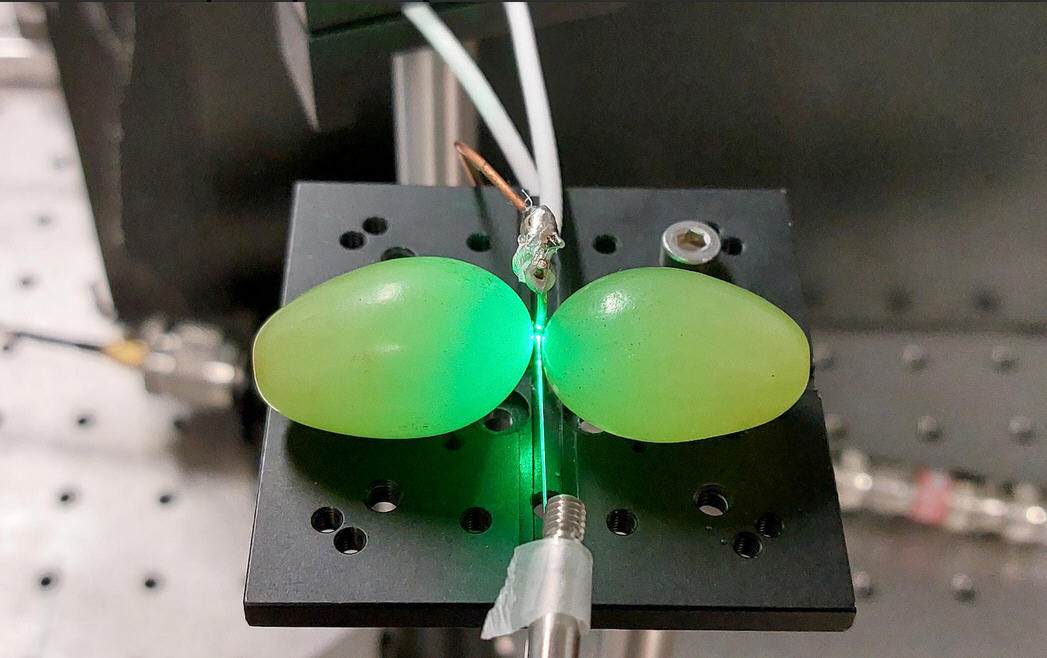博文
超市葡萄引发量子技术革命
 精选
精选
||
超市葡萄引发量子技术革命
诸平
据澳大利亚麦考瑞大学(Macquarie University)2024年12月31日提供的消息,超市葡萄引发量子技术革命(Supermarket Grapes Spark a Quantum Technology Revolution)。
麦考瑞大学的科学家们发现了一种利用普通葡萄提高量子传感器性能的新方法。通过利用葡萄的含水量和特定大小,他们创造了强磁场热点,提高了基于微波的量子传感的效率。
超级市场的葡萄和量子传感器(Supermarket Grapes and Quantum Sensors)
麦考瑞大学的研究人员发现,普通的超市葡萄可以提高量子传感器的性能,为更高效的量子技术铺平道路。
相关研究于2024年12月19日已经在《应用物理评论》(Physical Review Applied)杂志网站发表——Ali Fawaz, Sarath Raman Nair, Thomas Volz. Coupling nitrogen-vacancy center spins in diamond to a grape dimer. Physical Review Applied, 2024, 22(6): 064078. DOI: 10.1103/PhysRevApplied.22.064078. Published: 19 December 2024. https://doi.org/10.1103/PhysRevApplied.22.064078.其实,此文之前已经在预印本文库网站发表:arXiv:2311.03951 [quant-ph]. https://doi.org/10.48550/arXiv.2311.03951.它揭示了成对的葡萄在暴露于微波中时会产生集中的磁场热点。这些热点对量子传感至关重要,这一突破可能会导致创造更小、更便宜的量子设备。
上述论文的第一作者、麦考瑞大学量子物理学博士候选人阿里·法瓦兹(Ali Fawaz)解释说:“虽然之前的研究关注的是引起等离子体效应的电场,但我们发现葡萄对也可以增强磁场,这对量子传感应用至关重要。”
从病毒等离子体到量子创新(From Viral Plasma to Quantum Innovation)
这项研究建立在社交媒体上疯传的视频基础上,视频显示葡萄在微波炉中产生带电粒子的等离子体发光球。虽然之前的研究集中在电场上,但麦考瑞大学的团队研究了对量子应用至关重要的磁场效应。
该团队使用了含有氮空位中心的特殊纳米金刚石(nano-diamonds containing nitrogen-vacancy centers)——原子级缺陷,作为量子传感器。这些缺陷(是构成金刚石颜色的众多缺陷之一)的行为就像微小的磁铁,可以探测到磁场。
上述研究论文的合著者、麦考瑞大学量子技术讲师萨拉特·拉曼·奈尔博士(Dr Sarath Raman Nair)说:“纯金刚石是无色的,但当某些原子取代碳原子时,它们可以形成具有光学性质的所谓缺陷中心。我们在这项研究中使用的纳米金刚石中的氮空位中心(nitrogen-vacancy centers)就像微小的磁铁,我们可以将其用于量子传感。”
葡萄作为量子工具(Grapes as Quantum Tools)
该团队将其中含有特殊原子的金刚石量子传感器放置在一根薄玻璃纤维的尖端,,并将其放置在两颗葡萄之间。通过将绿色激光照射到光纤中,他们可以使这些原子发出红光。这种红光的亮度揭示了葡萄周围微波场的强度。
阿里·法瓦兹说:“使用这种技术,我们发现当我们加入葡萄时,微波辐射的磁场强度增加了一倍,即微波辐射的磁场强度是未加葡萄时的2倍。”
对量子技术小型化的影响(Implications for Quantum Technology Miniaturization)
上述论文的通讯作者、麦考瑞大学数理学院量子材料与应用小组(Quantum Materials and Applications Group at Macquarie’s School of Mathematical and Physical Sciences)负责人托马斯·沃尔兹教授(Professor Thomas Volz)说,这一发现为量子技术小型化开辟了令人兴奋的可能性。“这项研究为探索量子技术的替代微波谐振器设计开辟了另一条途径,有可能导致更紧凑、更高效的量子传感设备。”
葡萄为何有效:水分和大小的作用(Why Grapes Work: The Role of Water and Size)
葡萄的大小和形状对实验的成功至关重要。该团队的实验依赖于精确大小的葡萄,每个葡萄大约长27 mm,将微波能量集中在与金刚石量子传感器大约合适的频率上。
量子传感设备通常使用蓝宝石来实现这一目的。然而,麦考瑞大学的理论研究小组的理论认为,水的效果可能更好。这使得葡萄——大部分是包裹在薄皮中的水——成为测试他们理论的完美选择。
“水实际上比蓝宝石更擅长集中微波能量,但它也不太稳定,在这个过程中损失的能量更多。这是我们需要解决的关键挑战,”阿里·法瓦兹说。
未来创新灵感来自葡萄(Future Innovations Inspired by Grapes)
除了葡萄,研究人员现在正在开发更可靠的材料,可以利用水的独特性质,使我们更接近更有效的传感设备。
这项工作得到了澳大利亚研究委员会卓越工程量子系统中心{Australian Research Council (ARC) Centre of Excellence for Engineered Quantum Systems (EQuS)}的支持。
上述介绍,仅供参考。欲了解更多信息,敬请注意浏览原文或者相关报道。
Grapes double quantum sensor magnetic power in a groundbreaking experiment
Grapes of math: Quantum breakthrough bears fruit
Australian scientists boost quantum sensors using supermarket grapes
Macquarie University Harnesses Grapes for Quantum Sensing Advancement
Two grapes irradiated inside a microwave (MW) oven typically produce a series of sparks and can ignite a violent plasma. The underlying cause of the plasma has been attributed to the formation of morphological-dependent resonances (MDRs) in the aqueous dielectric dimers that lead to the generation of a strong evanescent MW hotspot between them. Previous experiments have focused on the electric-field component of the field as the driving force behind the plasma ignition. Here we couple an ensemble of nitrogen-vacancy (NV) spins in nanodiamonds (NDs) to the magnetic-field component of the dimer MW field. We demonstrate the efficient coupling of the NV spins to the MW magnetic-field hotspot formed between the grape dimers using Optically Detected Magnetic Resonance (ODMR). The ODMR measurements are performed by coupling NV spins in NDs to the evanescent MW fields of a copper wire. When placing a pair of grapes around the NDs and matching the ND position with the expected magnetic-field hotspot, we see an enhancement in the ODMR contrast by more than a factor of two compared to the measurements without grapes. Using finite-element modelling, we attribute our experimental observation of the field enhancement to the MW hotspot formation between the grape dimers. The present study not only validates previous work on understanding grape-dimer resonator geometries, but it also opens up a new avenue for exploring novel MW resonator designs for quantum technologies.
https://blog.sciencenet.cn/blog-212210-1466951.html
上一篇:水最可怕的噩梦:超疏水材料的兴起
下一篇:每天喝半到一杯葡萄酒可以降低50%的心脏并发症风险
